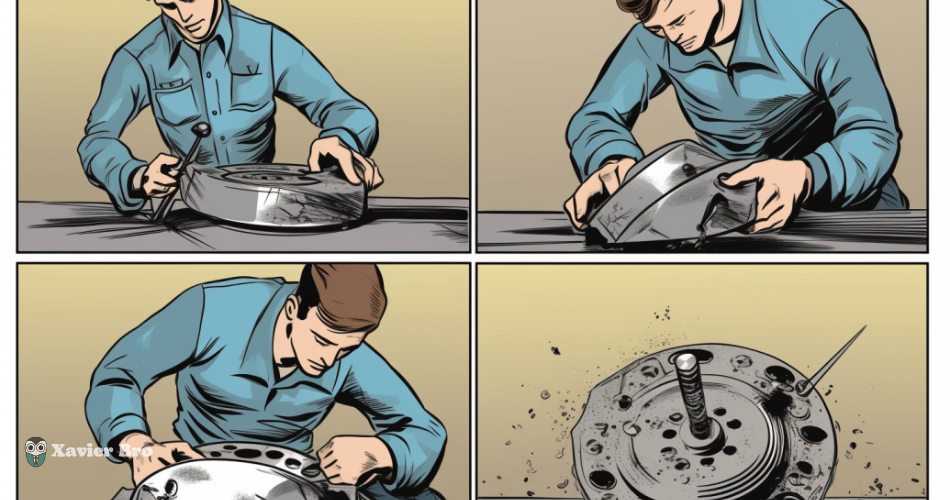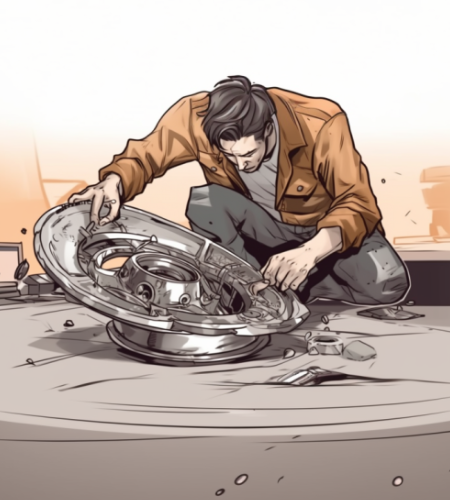Chrome plating is well-known to provide a shiny and protective finish to metal surfaces, like bumpers and trim pieces, appliances, plumbing fixtures, etc. It can start to show its age over time as the finish wears off or becomes clouded. At some point, you may want to remove the existing chrome plating to restore the base metal underneath. Removing old chrome plating takes patience and the proper set of tools. Here is a straightforward guide on how to remove chrome plating without damaging the original metal surface.
Key Takeaways
- Use a special chemical paint remover made for Chrome. Other kinds won’t work.
- Let the chemical sit for 5-10 minutes before wiping it off. Longer can harm the metal underneath.
- Use plastic scrapers and super fine steel wool to take the Chrome off. It prevents scratches.
- Clean and neutralize the metal after stripping so more damage doesn’t happen.
- Think about the type of metal before refinishing it with polish, powder coating, etc.
- Properly prepare, gently remove, and protect the metal. It is key to avoid problems when removing old Chrome plating.
Gather Your Chrome Plating Removal Tools
Removing chrome plating requires using chemicals or abrasives to break the plating’s bond with the underlying metal.
You will need the following tools:
- Chemical paint stripper – Look for methylene chloride-based strippers
- Plastic putty knife or scraper – Opt for a plastic tool to avoid scratching the metal surface
- Steel wool – Fine 000 or 0000-grade steel wool
- Sandpaper – 180-400 grit sandpaper
- Cleaning supplies – Such as towels, brushes, and a power washer
- Well-ventilated work area – Strip chrome rim outside or in a garage with the doors open
- Drop cloths or tarps – Protect surrounding surfaces from paint stripper runoff
With your supplies gathered, you can start removing the old chrome plating.
How to Remove Chrome Plating?
Let’s learn how to remove Chrome plating:
- Clean and prepare the surface – Wash the chrome-plated item with soap and water before stripping. It prevents other dirt or grease from interfering with the paint stripper. Lightly scuffing the Chrome with 400 grit sandpaper helps the chemical solution penetrate and act faster.
- Apply the paint stripper – Liberally coat the Chrome with a thick layer of methylene chloride-based paint stripper using a plastic putty knife or brush. Let it sit for 5-10 minutes to dissolve the plating fully.
- Wipe away softened plating – After several minutes, you should see bubbling and notice the chrome finish breaking down. Once the chrome plating is dissolved, carefully use a plastic tool to scrape away the loosened finish. Reapply more stripper to any stubborn areas.
- Scrub with steel wool – Dip 0000-grade steel wool in the stripper and rub to remove the remaining chrome residue. Rinse and scrub the piece with steel wool and a nylon brush under running water.
- Sand away final traces – If chrome remnants are left, wet sand with 400 grit paper to reveal the bare metal below. Rinse and wipe clean.
- Neutralize & clean – Wipe the stripped metal with baking soda and water. It neutralizes any remaining stripper. Give a final wash with soap and water, then let dry thoroughly.
- Polish or refinish – After thoroughly drying the stripped metal, it can be buffed and shined to restore its glossy appearance. Or, apply new plating or protective finish as desired.
Take proper safety precautions when handling paint-stripping chemicals and disposing of them properly.

Common Problems When Removing Chrome Plating
Employing suitable materials and proper methods can prevent many issues when stripping chrome plating. Old plating sometimes does not fully dissolve with just a paint stripper. If this happens, try gently sanding or using a wire wheel on areas where the Chrome is still stuck.
Be very careful sanding or scraping to avoid scratching the soft metal underneath.
It’s best to use plastic scrapers and very fine sandpaper. It prevents scratches and gouges in the metal. Some metals like aluminum and copper will become dull and oxidized when their chrome finish is removed. To keep the shiny look, polish the metal with a clear top coat or lacquer.
If the chrome plating hides corrosion or pitting, the bare metal can have an uneven texture. A filler primer can help smooth out those imperfections before painting or refinishing.
What to Do After Removing Chrome Plating
Once all the worn-out chrome plating is removed, the bare metal must be cleaned up and protected. There are a few options for refinishing the stripped metal:
Polishing the bare metal will help bring back its shiny look. Then putting on a sealant like a clear lacquer will prevent tarnishing. The metal part can be re-chromed for a more permanent fix to give it that original chrome finish.
It requires taking it to a professional chrome plating shop. Powder coating or painting gives good protection and color choices for many metals.
A thin, clear enamel coat also helps guard against corrosion and fingerprints on the bare metal. For temporary protection, you can apply a metal wax coating to slow oxidation and dulling.
Properly preparing and refinishing the raw stripped metal will keep it looking great while protecting it from future wear and tear.
Crazy Facts
- The chrome plating process was invented in the 1920s by engineers looking for a more corrosion-resistant metal finish.
- It gained widespread popularity in the 1950s and 60s as the shiny trend took off in auto and appliance design.
- The chrome plating process applies an electrical charge to lay down a thin chromium coating onto metal through a chemical solution. The chromium forms a transparent, mirrored coating just microns thick.
- The distinctive chrome look became a staple of space-age Googie architecture and mid-century modern style. Buildings like LAX airport featured prominent steel and aluminum chrome accents.
- While plastic chrome has replaced metal plating in some cost-conscious applications today, it remains popular in the automotive industry and high-end designs seeking an iconic chrome touch.
The Bottom line
When chrome plating starts to show its age, you don’t have to live with a worn, clouded finish. With some effort, standard tools, and the correct technique, you can safely remove chrome plating from metal to reveal the bare surface underneath.
Follow the steps for effective paint stripping, gentle scrubbing, and proper metal preparation. With this guide on how to remove chrome plating, you can give tired metal surfaces a fresh new look.
FAQs about How to Remove Chrome Plating
Is it safe to remove the chrome plating myself?
It’s generally safe with proper safety gear, ventilation, and handling of chemicals. Consider pros for large, complicated, or valuable pieces.
What happens if I leave the paint stripper on too long?
Leaving chemical strippers on too long can etch and burn the metal, leaving stains and an uneven surface texture. Wipe off residue as soon as the plating dissolves.
I hope you enjoy our article, do check out more of our amazing articles.
